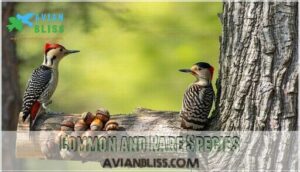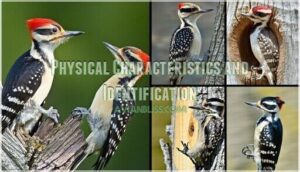This site is supported by our readers. We may earn a commission, at no cost to you, if you purchase through links.

You’ll spot them clinging to weathered bark, trading acorns, or darting among shadows—each species with its own rhythm, markings, and quirks shaped by territory and time.
Whether you’re hiking beneath tall pines or scanning backyard feeders, Arizona’s woodpeckers offer a glimpse into the story of survival across wild extremes.
Table Of Contents
- Key Takeaways
- Woodpecker Species Found in Arizona
- Arizona Woodpecker Habitats and Range
- Woodpecker Behavior and Diet in Arizona
- Conservation Status and Threats
- How to Attract and Spot Woodpeckers
- Frequently Asked Questions (FAQs)
- Are there woodpeckers in Arizona?
- What does an Arizona woodpecker look like?
- What does an Arizona woodpecker call?
- Are acorn woodpeckers common in Arizona?
- When do woodpeckers breed in Arizona?
- Are red-headed woodpeckers common in Arizona?
- Are Arizona woodpeckers protected?
- What does a gila woodpecker look like?
- Do Arizona woodpeckers migrate?
- How do Arizona woodpeckers communicate with each other?
- Conclusion
Key Takeaways
- Arizona is home to a variety of woodpecker species, each adapted to both forests and deserts with unique markings and behaviors.
- Habitat diversity and seasonal changes influence where you’ll find woodpeckers, from mountain canyons to backyard feeders.
- Most Arizona woodpeckers rely on insects, berries, and acorns for food, and many use cooperative breeding and distinct drumming to communicate.
- Conservation efforts focus on protecting habitat and monitoring populations, as climate change and habitat loss pose ongoing threats to these birds.
Woodpecker Species Found in Arizona
Arizona’s woodpeckers bring a surprising amount of variety, from bold colors to distinct beaks and behaviors. Some are regular visitors across the state, while a few remain rare finds.
Here’s a look at the species you might encounter on your next walk.
Common and Rare Species
When you explore Arizona, you’ll encounter a surprising mix of woodpecker species. The Acorn Woodpecker and Northern Flicker are abundant, often flocking in oak groves or open woods.
Rarer finds, like the Arizona Woodpecker or elusive Red-headed Woodpecker, reveal how habitat specificity and changing population dynamics shape the conservation priorities for woodpecker species in Arizona. They’re commonly found in mixed pine-oak environments.
Physical Characteristics and Identification
Spotting a woodpecker in Arizona can be a real treat, especially once you know what sets each one apart—from the bold splash of red on an Acorn Woodpecker’s head to the subtle, speckled markings on a Northern Flicker’s belly. Look closely for:
- Unique plumage variations across Arizona Woodpecker species
- Noticeable size comparison between Downy and Hairy Woodpeckers
- Distinguishing features like regional differences in head or belly markings
Arizona Woodpecker Habitats and Range
Arizona is home to woodpeckers that adapt to all sorts of landscapes, from thick forests to dry deserts and rocky mountains. Where you spot a woodpecker depends a lot on the species and the season.
Here’s a look at the habitats and ranges where you’re most likely to find them.
Forest, Desert, and Mountain Habitats
You’ll notice woodpeckers in Arizona pop up just about everywhere, from dense ponderosa pine forests to sunbaked saguaro stands.
Their adaptability is tied to habitat diversity—each species reads microhabitats and resource availability like an old friend.
Elevation impact, seasonal changes, and even cactus groves shape which desert birds or forest birds thrive, showing off nature’s cleverness.
Species Distribution Across Arizona
The distribution of woodpeckers across Arizona follows a patchwork of habitats and altitudinal ranges. Some, like the Arizona Woodpecker, claim mountain slopes and sycamore-walnut canyons, while others stick to deserts or higher forests.
Overlapping territories pop up where oak, pine, and riparian woodlands meet, but habitat fragmentation and shifting climate impacts are already reshaping population density and species strongholds.
These woodpeckers primarily consume beetle larvae, berries, and acorns.
Birdwatching Hotspots
If you’re hoping to cross a few woodpecker species off your Arizona birding list, start by heading where water meets woodland and the landscape hums with life.
Forest trails in the Sky Islands, mountain peaks near Tucson, and desert locations rippling with blooms all make for prime Arizona bird watching—especially during favorable seasons and guided tours focused on woodpecker habitat.
Woodpecker Behavior and Diet in Arizona
Curious about what Arizona’s woodpeckers do from sunup to sundown? Let’s look at how they find their meals, interact with each other, and communicate in their own unique way.
Here are the main things to watch for.
Feeding Habits and Food Sources
Curious how Arizona woodpeckers fill their bellies each day? These birds master survival with clever dietary adaptations. Here’s how their menu stacks up:
- Insect Consumption—beetles, ants, and bugs fuel most woodpeckers.
- Acorn Storage—Acorn Woodpecker stashes nuts for lean times.
- Sapsucker Sap—Red-naped Sapsuckers drill for sweet tree sap.
- Ground Foraging—Northern Flickers hunt ants in dirt.
- Arizona Woodpecker—dives for insects in tree bark.
Social and Nesting Behaviors
Ever seen a bird build its own apartment? Arizona Woodpecker families do just that, with monogamy and plenty of teamwork. Their Group Dynamics often mean Cooperative Breeding—helpers chip in with Parental Care.
Each nest cavity is hot real estate, sparking Cavity Competition. Nest Construction happens in dead wood, with careful selection for the safest, most hidden nest site possible.
Vocalizations and Drumming
Every woodpecker has its own way of announcing itself, turning quiet forests into lively stages with bursts of tapping, rolling calls, and rhythmic drumming. For Arizona Woodpeckers, drumming isn’t just noise—it’s deliberate Territory Defense.
Their vocalizations and calls form a key part of vocal communication, with unique sound analysis revealing clear Species Variations, important to understanding avian behavior in these habitats.
Conservation Status and Threats
Arizona’s woodpeckers face a mix of challenges that shape their future in the wild. If you’re curious about which species are at risk, what’s threatening them, or how people are stepping up to help, you’re in the right spot.
Let’s look at the biggest conservation concerns and efforts happening right now.
Species at Risk and Population Trends
Spotting an Arizona Woodpecker never feels routine—with each sighting, you’re witnessing a species that’s stable for now, but not immune to change. Population decline isn’t the pressing issue here, thanks to effective monitoring programs and adaptive conservation strategies.
Still, experts keep a close watch on habitat fragmentation to make certain this distinctive bird remains off the IUCN Red List.
Habitat Loss and Climate Impacts
Even though the Arizona Woodpecker’s numbers seem stable, their world is changing. You see it in how forest fragmentation carves up their habitat. Climate change brings more frequent fires and longer droughts.
The chain reaction continues: 1. Fewer trees mean less food. 2. Insects decline. 3. Birds shift to new elevations, changing the rhythm of Arizona’s forests.
Conservation Efforts in Arizona
That’s why Arizona’s conservation work takes a hands-on, local approach. Efforts include habitat restoration along rivers, legal protections under the Migratory Bird Treaty Act, and regular monitoring research to stay ahead of changes.
Community engagement programs, from bird walks to citizen science, help you witness the Arizona Woodpecker up close and play a role in its conservation status story.
How to Attract and Spot Woodpeckers
If you’d like more woodpeckers in your yard or want to spot them out in the wild, there are a few things you can do to make it easier. The right food and nesting spots can help bring these birds close.
Here are some ways to encourage woodpeckers to show up and stay awhile.
Backyard Feeding Tips
With a little planning and the right snacks, you can turn your yard into a favorite spot for woodpeckers looking for a hearty meal.
Attract woodpeckers with these tips:
- Offer suet feeders for extra protein.
- Choose seed mixes with black oil sunflower seeds and peanuts.
- Provide clean water sources for drinking and bathing.
- Practice safe feeding—keep feeders spotless, and avoid chemical pesticides.
Providing Nesting Sites
Just as the right snacks lure woodpeckers to your yard, a few smart changes can make it the perfect neighborhood for nesting, too. Leave dead trees for natural nest cavities—a mainstay for woodpecker nesting habits.
Consider DIY nest boxes that match local cavity size and woodpecker preferences. Use predator protection and practice snag management. Spotting a new nest is a thrill!
Best Practices for Birdwatchers
If you want to catch a woodpecker in action, nothing beats a quiet spot and a steady gaze. Listen for soft tapping or drumming, keep to trails, and respect wildlife by minimizing your impact—ethical birding means putting habitat preservation first.
Share sightings, use Arizona Woodpecker identification resources, and try diverse bird watching locations for a richer backyard birdwatching experience.
Frequently Asked Questions (FAQs)
Are there woodpeckers in Arizona?
You’ll find woodpeckers in Arizona’s forests, deserts, and even your backyard. Thanks to impressive woodpecker adaptations, the state hosts rich species diversity—each with unique appearances and seasonal presence, challenging your identification skills whenever you’re out exploring Arizona wildlife.
What does an Arizona woodpecker look like?
Snap a Polaroid in your mind: plumage variations among woodpecker species in Arizona range from bold stripes to muted browns. Identification hinges on size differences and unique marks. Regional morphology and juvenile appearance add layers to the puzzle.
What does an Arizona woodpecker call?
You’ll notice sharp, high-pitched chirps and rolling rattles among woodpeckers in Arizona.
These bird vocalizations and calls vary by species, helping with woodpecker identification. Call meanings can signal territory, attract mates, or warn others of danger.
Are acorn woodpeckers common in Arizona?
Spotting an Acorn Woodpecker in Arizona isn’t rare—their population density thrives where acorn abundance is high. Their social structure revolves around communal food storage, with granaries hinting at strong habitat preference. It’s a peak experience among woodpeckers in Arizona.
When do woodpeckers breed in Arizona?
Woodpecker breeding season in Arizona begins by mid-winter. Breeding rituals include excavating nest cavities, usually laying a Clutch Size of about three to five eggs, followed by a two-week Incubation Period.
During nesting season, both parents share Fledgling Care.
Are red-headed woodpeckers common in Arizona?
Rarely seen, the Red-headed Woodpecker is a vagrant species in Arizona. Overlaps in habitat may cause species confusion; accurate Red-headed ID is key.
Report sightings, as their population status is low compared to other local woodpecker species.
Are Arizona woodpeckers protected?
Legal protections and conservation laws in Arizona help safeguard woodpecker populations. Most species are included under state and federal regulations, protecting them from hunting or harm.
Habitat preservation, population monitoring, and IUCN Red List conservation status all support ongoing conservation efforts.
What does a gila woodpecker look like?
Picture sunlight glinting off a Gila Woodpecker’s tan body and boldly striped black-and-white wings. With its red crown spot (on males), strong beak, and noisy calls, it’s at home among saguaro cacti—classic desert adaptation in action.
Do Arizona woodpeckers migrate?
Migration patterns in Arizona woodpeckers are subtle. Most are considered resident species, sticking around year-round.
Some, like the Red-naped Sapsucker, show seasonal movements or altitudinal migration, influenced by climate and geographic distribution across Arizona’s habitats.
How do Arizona woodpeckers communicate with each other?
Drumming signals carry across forests, letting woodpeckers in Arizona announce territory defense or attract mates.
Bird vocalizations and calls share social signals, while visual cues—like wing-flashing—add extra layers to woodpecker behavior and their active vocal communication.
Conclusion
Investigate the truth of a theory: the wildest parts of Arizona are shaped by more than heat or stone—they’re written in the flight and work of birds like the Arizona woodpecker. Watch them for a lesson in patience, adaptation, and resilience.
Their tapping threads together forest and desert, present and past, in a language anyone can learn if they stand still long enough.
Your own backyard, with the right care, might just become part of the story.









